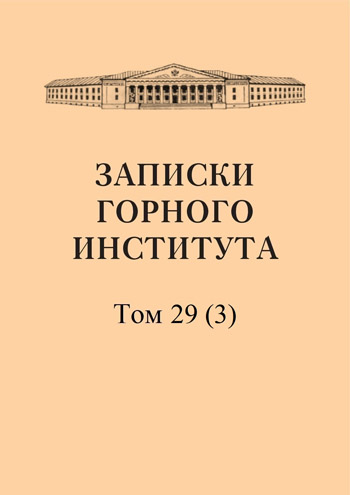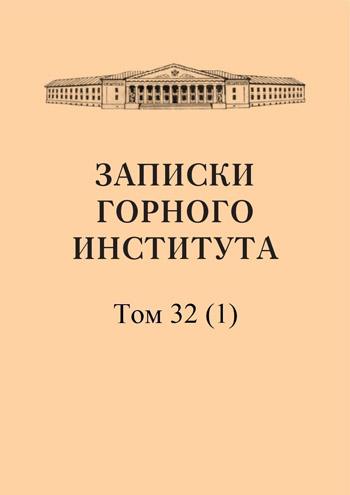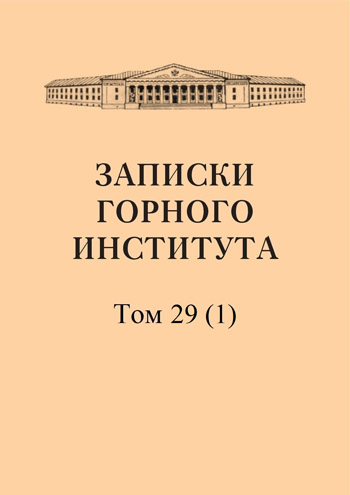-
Date submitted1953-09-06
-
Date accepted1953-11-13
-
Date published1954-07-27
On integral transformations with a stochastic kernel
- Authors:
- O. V. Sarmanov
The aim of this paper is to study the properties of integral transformations of the form ϕ (χ) = ʃ r(y) K(x, y) dy, performed on the function r (y) by means of the stochastic kernel K(x, y). According to the generally accepted terminology, the kernel is called stochastic if it satisfies the conditions (see the article). The study of the properties of the transformed function ϕ (χ) naturally splits into two cases: symmetric and asymmetric F(x, y). The article considers questions about the functional moments of symmetric correlation and about the functional moments of asymmetric correlation.
-
Date submitted1953-09-03
-
Date accepted1953-11-19
-
Date published1954-07-27
Probabilities of highly fluctuating values
In many experimental studies, the presence of some phenomenon is established by observing a "signal", i.e. by establishing that some, as we will say, elementary event A is realized. However, this elementary event can also be caused by secondary causes not related to the phenomenon under study. In such a case, only repeated occurrences of event A will allow us to judge with sufficient certainty the presence of the phenomenon under study. Let us conduct a series of n experiments, where event A can appear with some probability p. The phenomenon of interest to us (we will call the implementation of this phenomenon event M) can be connected to varying degrees with elementary event A. It is natural to assume that there is a rather weak dependence between event M and elementary event A if, in order to obtain certainty of the realization of M, it is necessary to observe A sufficiently often in n trials (for example, at least once t times in a row). In this paper, we limit ourselves to considering only three types of dependence of events M and A, the most important for applications (see the article).
-
Date submitted1953-09-13
-
Date accepted1953-11-19
-
Date published1954-07-27
Photovoltaic effect on titanium dioxide
- Authors:
- Z. E. Lobanova
A necessary condition for the occurrence of the photovoltaic effect is the presence of a film of oxide, halogen or sulfur compounds of metals on the clean metal surface of the illuminated electrode. It can be stated that most of the studied photosensitive layers are compounds related to the type of semiconductors, and the photovoltaic element can be considered as a system consisting of a semiconductor bordering a metal electrode on one side, and an electrolyte on the other. Thus, it is natural to compare the photovoltaic effect with the internal photoelectric effect characteristic of semiconductors. The advantage of titanium dioxide over copper oxide is its chemical inertness, which allows for a wide variation in the conditions of the medium bordering the electrode. Based on the spectral characteristics of the positive and negative signs, it can be concluded that photocurrents of both signs are caused by electronic processes in the semiconductor that are independent of each other.
-
Date submitted1953-09-24
-
Date accepted1953-11-23
-
Date published1954-07-27
On a class of linear integro-differential equations in partial derivatives of the first order
- Authors:
- T. I. Vigranenko
In this note, we study solutions of the integro-differential equation (see article). This solution depends on q arbitrary parameters. If for λ = λ' equation (51) has no solutions, then the Cauchy problem under consideration has no solutions. Finally, we note that if the determinant (40) on the manifold (39) vanishes, then system (43) is not solvable, or is solvable uniquely with respect to S and tk. Therefore, equation (46) will include arbitrary parameters. Consequently, if the initial manifold (39) is characteristic, then equation (1) has none, or has an infinite number of solutions.
-
Date submitted1953-09-29
-
Date accepted1953-11-02
-
Date published1954-07-27
Study of mechanical and technological properties of lead brasses
- Authors:
- N. N. Ivanov-Skoblikov
In a number of cases, when the product is exposed to chemical or mechanical influences, the material for its manufacture is brass with lead additive. A special lead additive to brass is produced in the manufacture of: a) wire, rod and sheet material, high malleability of which is combined with good ability to cold processing - drilling and milling and b) alloys for casting, for the purpose of good processing with cutting tools. In this case, brittle and short chips are usually obtained. This essay is the result of research into the extreme limits of lead content in brass according to GOSTs and some special types of brass containing lead used in industry. Research (see article) has shown that α-brasses containing 67-74% copper resist cracking well if they contain from 2.5 to 3% lead. Alloys of the L60 type, containing 2.5% lead, behave somewhat worse. Very poorly resist cracking of brass of the type 60-63% copper, containing 1.5-1.8% lead. Consequently, the best alloys with respect to "spontaneous cracking" are leaded a-brasses.
-
Date submitted1953-09-19
-
Date accepted1953-11-30
-
Date published1954-07-27
Application of the method of rectangular coordinates to the solution of some problems of photogrammetry
- Authors:
- P. V. Filippov
In this paper, the solution to the problem under consideration is shown on the basis of the mutual connection between the methods of central and parallel projection. This mutual connection can be established by the method of rectangular coordinates in application to the named design methods. The method of rectangular coordinates quite definitely establishes a mutual connection between the different design methods - central and rectangular. The mutual connection allows, in matters of transforming central projections into rectangular ones, to use uniform simple relationships that take place when designing the main geometric image - a point. The use of these relationships is equally applicable to any case of the position of the plane of the picture relative to the coordinate system, which can be considered as a completely definite pattern. The transformation of central projections into rectangular ones can be carried out when solving photogrammetry problems related to determining the shape, size and position in space of objects from their photographs on a plane occupying any position relative to the surface of the earth.
-
Date submitted1953-09-24
-
Date accepted1953-11-20
-
Date published1954-07-27
Stresses in a rotating rod with a special cross-section shape
- Authors:
- A. F. Zakharevich
The problem of stress distribution in a prismatic rod rotating around one of the main central axes of inertia of the cross-section is reduced to solving two independent problems. One of them does not depend on the shape of the cross-section contour and is solved once. The second problem depends on the shape of the cross-section contour and is reduced to determining the plane strain state. With an accuracy quite sufficient for practice, the value of the main design stress can be obtained using the simplified formula (7) (see article). Assuming in the obtained expressions for stresses a = 0 and bр = r, we obtain stresses for a rod of circular cross-section.
-
Date submitted1953-09-02
-
Date accepted1953-11-08
-
Date published1954-07-27
On the physical basis of deformation and destruction of metals
- Authors:
- I. I. Tarasenko
According to modern views, all metals are a crystalline spatial lattice of ions in its nodes and free (socialized) electrons. The process of metal deformation is usually divided into three stages: 1) elastic (reversible) deformation, in which the distances between the elements of the atomic lattice change without changing the structure of the substance; 2) plastic (irreversible) deformation, in which local changes occur in the structure of the metal, associated mainly with a change in the size and shape of crystals and deformation of the intermediate layers; 3) destruction. In order to form a correct idea of the overall strength of the material, it is necessary to evaluate its behavior in all three stages. The division of the deformation process into three stages is purely conditional. In reality, in the elastic section, there is also a small plastic deformation, in the section of plastic deformation, both elastic deformation occurs and processes directly associated with the destruction of the material are generated (see article).
-
Date submitted1953-09-29
-
Date accepted1953-11-10
-
Date published1954-07-27
Calculating the strength for ultimate bending loads
- Authors:
- I. I. Tarasenko
Experimental studies have established that during plastic bending of a rod in the region of small plastic deformations, there is no curvature of the planes of cross sections that have two axes of symmetry. This is true for materials that equally resist tension and compression and for materials that do not equally work under tension and compression. Bending is a very common, if not the most common, type of deformation in structures and machines. Therefore, for the full use of the material and the lightening of structures, the correct approach to calculating the bearing capacity of a rod during bending is one of the pressing issues. The need to determine bending moments for any values of plastic deformation also arises during cold stamping. The approximate formulas obtained in this work for calculating bending moments throughout the plastic deformation of a rod can be used in practice.
-
Date submitted1953-09-18
-
Date accepted1953-11-24
-
Date published1954-07-27
Study of elastic line of semi-rigid coupling
- Authors:
- L. S. Burstein
Increasing the elasticity of a coupling sleeve is usually achieved by installing one or more corrugations. A schematic representation of such a corrugation in deformed and undeformed states is shown in Fig. 1. (see article). The main value that determines the elasticity of the sleeve during bending is the rotation angle a. It depends on the magnitude of the bending moment, the dimensions and material of the corrugation. There are various theoretical and experimental methods for determining the value of a, which we will not dwell on - we will take the angle a, as well as the dimensions of the sleeve, as specified. The task is to determine the effect of the corrugation on the movements of the entire sleeve and its individual elements. These movements depend not only on the characteristics of the corrugation, but to a large extent on the position occupied by the corrugation on the sleeve and the dimensions of the sleeve itself.
-
Date submitted1953-09-01
-
Date accepted1953-11-30
-
Date published1954-07-27
Photovoltaic effect on copper oxide
- Authors:
- Z. E. Lobanova
A large amount of experimental material has been presented in works on photovoltaic phenomena. The elucidation of the general laws governing these phenomena is complicated by the fact that the photoelectric effect occurs in the "electrode-solution" system, where the slightest changes are manifested in a violation of the established potential. Due to these considerations, the results obtained by different authors for the same object are contradictory and often irreproducible. This article establishes a number of important laws (see article).
-
Date submitted1953-09-17
-
Date accepted1953-11-15
-
Date published1954-07-27
Current state of the issue of research and construction of the phase diagram of the ternary system [copper - manganese - aluminum]
- Authors:
- N. N. Ivanov-Skoblikov
The phase diagrams of the aluminum-copper, aluminum-manganese, and copper-manganese systems, which bound the spatial phase diagram copper-manganese-aluminum on three sides, have been studied for a number of years by many Russian and foreign researchers and were described in some detail by Hansen as of 1936. Hansen gave a critical review of the studies he had studied and provided fairly complete bibliographic data. Further bibliographic data up to and including 1942 (but without any review) were published by Hotton. There are indications that in 1944 Rayner published annotations supplementing the previous works. A study of the literature of recent years has made it possible to find significant refinements to the phase diagrams of the metallic systems under consideration. The article examines the research data: 1. According to the aluminum-copper phase diagram. 2. According to the aluminum-manganese phase diagram. 3. According to the copper-manganese phase diagram. 4. Ternary phase diagram of the copper-manganese-aluminum system (see article).


